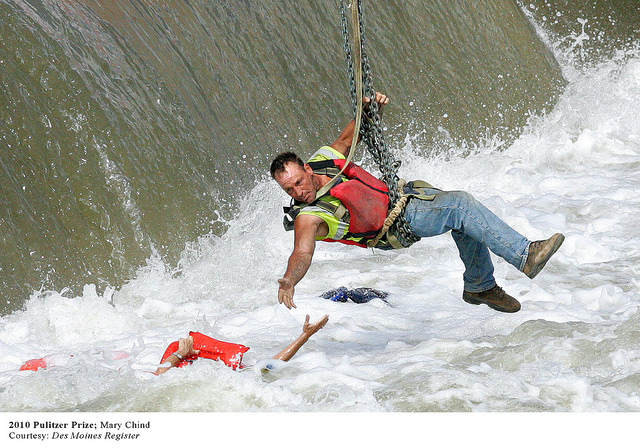
Photojournalism, a slice of time, constrained from being art
The collection of Pulitzer-Prize winning photographs which opens at the Frost Museum this week brims with pathos and the passage of time. The photos are expertly composed; that’s quite a feat, as most were shot in what Henri Cartier-Bresson called “the decisive moment”—that split second when everything makes sense, only to descend again into chaos. But they’re not art. They could be, but then they wouldn’t be photojournalism.
To paraphrase Gertrude Stein, a photo is a photo is a photo. Nothing within the picture plane can be used to ground a photograph securely within the different fields of art, journalism, advertising, or, as we have seen over the past decade, social media. As such, all designation takes place outside the frame—in the photographer’s intent, in any alterations, and in our reception. The journalistic photograph has a specific relationship with truth that, while not counter to the goals of art, often gets in the way.
Take a moment to examine the portmanteau at the root of this debate: photojournalism. (-Graphy, the drawing part, has been notably dropped, and not just because the word journophotography sounds ridiculous). No, photography is truncated. It is placed as prefix, as adjective. It is, thus, secondary to journalism and to the pursuit of journalistic truth. Related Link

“Four reasons why great photojournalism is art” by Eric Newton on KnightBlog.org
Consider Walker Evans’s photographs of Alabama sharecroppers. These images have become unhinged from the story they once illustrated, “Let Us Now Praise Famous Men,” James Agee’s chronicle of the Great Depression. For better or worse, they now stand alone, searing portraits of timeless poverty and desperation—hardships that greatly outreach the initial assignment from Fortune magazine. Much as the farmers were uprooted by the Dust Bowl, the images have also been deracinated, as is evidenced by Sherrie Levine’s “After Walker Evans” series (1981) of direct appropriations. They now exist on their own, as art.
The journalistic photograph often depends upon the story it illustrates. The caveat that this happened, this is real saves many an image. Kevin Carter’s “Waiting Game for Sudanese Child” (1994) features a vulture waiting patiently for a starving toddler to die. This image’s power relies on the fact that that vulture and that child were both once alive. (It’s also fueled by Carter’s subsequent suicide, but that’s another story). Pretend that the image was staged, however, and it immediately becomes lurid and overwrought—a cartoon of grief.
Journalism needs fidelity, in more ways than one. The best photojournalists are adept at composition and cropping and, above all, timing. But you mustn’t be too adept. To take a photograph is to slice a moment out of time, and in this way, cropping and composition become tools for selection and story-forming. This gets tricky when you’re trying to present an unbiased record of an event. Once the photograph is taken, any sort of post-production work beyond the most marginal color correction is unacceptable. Journalism binds the photographer to faithful representation of the world—a necessary demand upon a photojournalist, but one we do not and cannot make on an artist. Perhaps this is why Robert Capa’s D-Day images still resonate so strongly. Quite infamously, they were given an inadvertent bit of post-production when a studio assistant at Life magazine accidentally melted the emulsion on the film, causing many of the images to be distorted. This partial destruction adds to the fog of war, and the heightened disorienting blur of fear the GI’s must have felt that morning.
To put this another way, I’d suggest that what makes great photographs truly great is how they get at the unknown, or that which is beyond the truth. Take one of my favorite images, William Eggleston’s “The Red Ceiling” (1973). There’s nothing to know there, no truth to tell. But the feelings, and the hunches? They go on for days.
Hunter Braithwaite is editor of The Miami Rail, a Knight Foundation grantee that provides arts and culture coverage about South Florida in print and online.
Recent Content
-
Artsarticle ·
-
Artsarticle ·
-
Artsarticle ·

